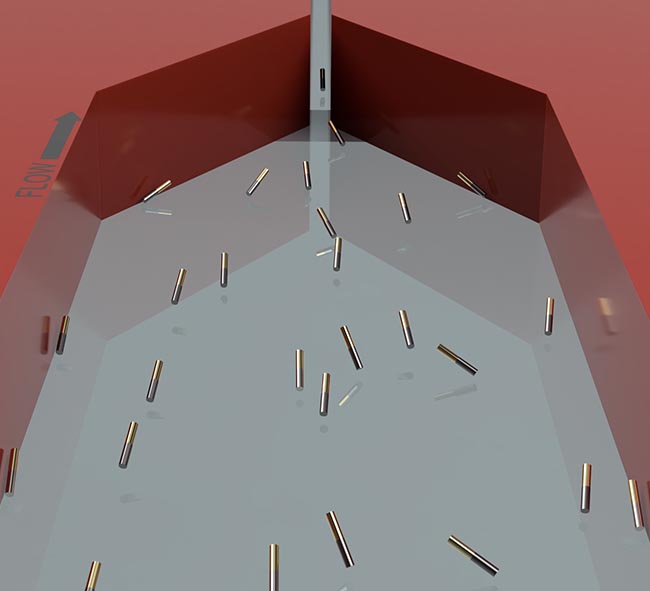
Chemically self-propelled gold–platinum nanorods tilt like a weathervane against the flow, Penn State researchers found. IMAGE: LEONARDO DOMINGUEZ RUBIO, PENN STATE
Biomedical engineers find active particles swim against the current
12/1/2020
By Ashley J. WennersHerron
UNIVERSITY PARK, Pa. — Researchers are beginning to understand the behavior of so-called “active” particles, which, if it can be controlled, has potential implications for engineered drug delivery systems and smart 3D printing, according to an interdisciplinary Penn State research team.
Led by Igor Aronson, Dorothy Foehr Huck and J. Lloyd Huck Chair Professor of Biomedical Engineering, Chemistry and Mathematics, the researchers published their new findings on active particles on Nov. 16 in Advanced Intelligent Systems.
Typically, the particles — which can be biological but, in this case, are cylindrical platinum-gold nanorods, smaller than a red blood cell by half — flow in fluid through a micro-channel into a tapered nozzle. Once collected there, they can be used in additive manufacturing to 3D print objects or to deliver therapeutics directly to cells.
When the particles can consume energy from the environment and become active, however, their behavior changes, according to Leonardo Dominguez Rubio, first author on the paper and doctoral student in Aronson’s lab.
The researchers dosed the nanorods with hydrogen peroxide, creating energy the nanorods can harness and convert to mechanical movement.
“These particles swim,” Dominguez Rubio said. “They self-propel. That makes them smart. If we can control their position and orientation, we can exploit their properties.”
According to Dominguez Rubio, if all particles are aligned in a material, then the mechanical properties of the material could exhibit one characteristic in one direction and another in a different direction. The issue is understanding how to control the alignment.
“There’s significant research on the transport of passive particles of various shapes,” Aronson said. “Over the last hundred years, the scientific community has developed a good understanding of how this happens. We can reliably manipulate passive particles. Active particles, however — the swimming particles exhibit completely different behavior that we’ve just started to explore.”
In contrast to the passive particles that float to the tapered nozzle, remaining parallel to the bottom of the container and somewhat evenly spaced throughout the solution, the active swimming particles pop upright and tilt against the flow. They also clump along the walls of the container and at the nozzle entrance.
“The flow parameters are different,” Dominguez Rubio said. “We need to understand them in order to quantify and develop a model for this behavior.”
Dominguez Rubio explained that once the researchers can understand and manipulate the flow parameters, they can begin to apply them. Right now, however, he said, the problem is like attempting to administer a drug to a patient. The physician wants the drug to go into the patient, but the drug actively swims away from being injected.
“In this research, we discovered that the motility mechanism and self-organization is much more complex than we imagined in the beginning,” Aronson said.
The researchers will continue to develop a model to predict particle behavior, as well as experiment with how the shape of the nozzle affects active particle movement through it.
Other contributors include Mykhailo Potomkin, assistant professor at the University of California, Riverside, who conducted this work as an assistant research professor at Penn State; Remmi Danae Baker, former doctoral student in Aronson’s lab and now a researcher at CELLINK in Sweden; Ayusman Sen, professor of chemistry in the Penn State Eberly College of Science; and Leonid Berlyand, professor of mathematics in the Eberly College of Science. This work was supported by the National Science Foundation and Penn State.



